OZ2. Ozone in Nature
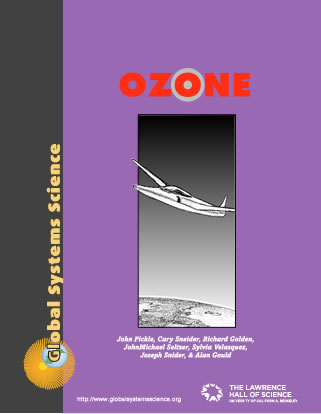
Chapter 2
{ Ozone Contents }
In order to understand the mystery of why ozone over the South Pole was being destroyed, it is necessary to learn more about ozone and other chemicals that affect it. This will be the subject of Chapters 2, 3, and 4. We’ll return to the mystery in Chapter 5.
I. Ozone Up Close and Personal
“When I was a kid, as soon as summer vacation came, my family would move to a cabin in the nearby mountains to escape the heat of the city. I remember it clearly although the incident happened nearly 50 years ago. The day had been hot and sultry and, as I stood near the front door of the cabin, I was enjoying the cool wind that had sprung up. White clouds sailed across the bright blue sky with tops like cauliflowers. As I watched, the tops grew and spread upward at an extraordinary rate. It was as if the clouds were boiling. Occasionally a cloud blocked the Sun and the shadow rushed across the meadow in front of me and darkened the woods beyond. Suddenly the darkness deepened and it became as dark as twilight. It felt as if the day had abruptly been cut short. The wind stopped and the woods became very quiet.
“Without warning the whole scene suddenly turned white. The light was blinding and with it came a crack like that of a tremendous tree branch breaking but much, much louder, like an explosion. I found myself on my hands and knees on the floor inside the cabin without knowing how I got there. My closed eyes still saw the meadow and trees as gray outlines in a field of white. I began to smell a strange odor. It filled my nostrils uncomfortably and caught in my throat. I started to cough and wanted to sneeze at the same time. I now know it was ozone gas, created by the lightning.
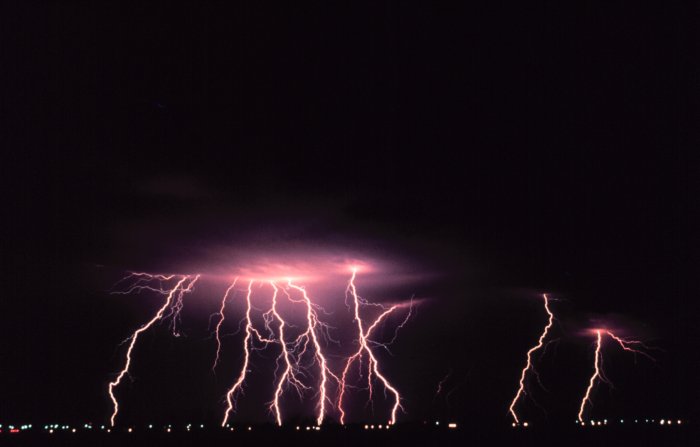
“I got to my feet and saw that the trunk of a large oak tree on the edge of the meadow was on fire. Green leaves were slowly falling down from the upper branches. A black scar curled down the trunk and in the lower section, close to the ground, yellow-orange flames were leaping from the black streak. The grass at the base of the tree was brown and smoking. With a sudden rush, a strong wind swept across the meadow and immediately after, large drops of rain began to pound down. The fire hissed and was gone. The smell of ozone disappeared. The rain became heavier and sheets of it were blown across the meadow. Within a half hour the rain ended and the drops that fell from the leaves sparkled in brilliant sunlight.”
II. What Is Ozone?
The distinctive pungent-smelling gas associated with lightning was familiar to many people who were near lightning bolts when they struck the Earth, but it was not until 1840 that it was given the name of ozone. The name was based on the Greek word ozon, meaning to have odor. This was at the time that experiments with electricity began to be performed and it was observed that the odorous gas was produced when even small electrical sparks passed through the air.
The aircraft flying out over the Antarctic from Chile in 1987 were searching for ozone. Ozone consists of three connected oxygen atoms, O3, whereas the dominant form of atmospheric oxygen consists of two connected oxygen atoms, O2 (often referred to as molecular oxygen or dioxygen). Ozone is formed from the O2 molecules in the atmosphere. About 21% of the air is composed of molecular oxygen, and most of the rest is nitrogen (78%). Nitrogen gas occurs as a connected pair of atoms, N2. Whenever we take a breath we are inhaling both oxygen (O2) and nitrogen (N2) and a variety of trace gases, but our bodies use only the oxygen.
III. Dioxygen (O2) vs. Ozone (O3)

An allotrope is a molecule made up of only one type of atom, for example, ozone and dioxygen. The chemical properties of allotropes of a particular atom can be remarkably different. For example, carbon as graphite in pencils is quite different from carbon as diamonds in wedding rings!
What causes the difference in physical properties of allotropes? As with molecules made of an assortment of atoms, it is the molecular structure of the combined atoms that creates the physical properties of the molecule. The primary factors of molecular structure are the strength and arrangement of the bonds between the atoms. The strength of the bonds depends on the number of electrons shared between the atoms. In the case of dioxygen, two pairs of electrons are shared which creates a strong bond that is not easily broken in a chemical reaction. Ozone, on the other hand, has a third atom attached by a weak bond due to sharing just one electron. Ozone is therefore less stable than dioxygen, and it can be broken down easily and combined with other molecules.
IV. Making A System Map of Ozone Production
To understand how ozone interacts with energy and other molecules, it’s helpful to draw a diagram.
As illustrated here, a lightning bolt does not make ozone directly; it breaks up dioxygen molecules (O2) so that the free oxygen atoms can combine with other dioxygen molecules to form molecules of ozone (O3).
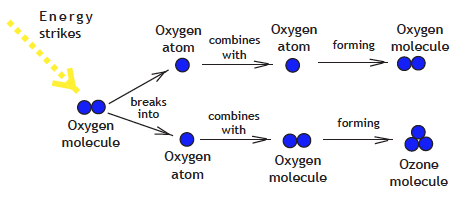
In the stratosphere, between about 18 km and 30 km above the Earth’s surface, the source of energy is not lightning. It’s sunlight.
Question 2.1.
See if you can point to places in the diagram above where the following interactions take place.

Sunlight is composed of light of many different colors, each color having a different energy. The entire range of colors is called the solar spectrum. An instrument that breaks up light into all of its colors is called a spectroscope, and one that can measure the intensity of the colors is called a spectrometer. Some spectrometers can allow us to detect “colors” that are invisible to the eye. Invisible colors include infrared light and microwaves, which are beyond the red end of the spectrum, and ultraviolet light and x-rays, which are beyond the violet end of the spectrum.
In 1881, two scientists, W.N. Hartley and A. Cornu, found an unexpected missing section of the spectrum of energy coming from the Sun. There was energy missing in the ultraviolet portion of the spectrum. In an attempt to explain their findings, they discovered that the gas ozone could absorb ultraviolet light, just as filters on colored theater spotlights absorb certain colors from the visible light spectrum. But the amount of ozone available near the surface of the Earth was much too small to be responsible for the absorption. The scientists deduced that a much larger quantity of ozone must exist in the upper atmosphere. Today we know that their hypothesis was right. Samples of air taken at different altitudes confirm that there is an ozone-enriched layer in the stratosphere.

OZ2.1. Investigation:
Spectrum of the Sun
You can break up sunlight into its colors with a glass or plastic prism, or with a diffraction grating (a sheet of plastic ruled with very tiny lines).
You can break up sunlight into its colors with a glass or plastic prism, or with a diffraction grating (a sheet of plastic ruled with very tiny lines).
Materials
- mirror
- prism or diffraction grating and cardboard slit
- colored filter gels
Strategies for Investigation
- Place a mirror in the sunlight on the windowsill and close all the shades to darken the room, so that only the reflected beam of sunlight enters the room.
- Use the prism or diffraction grating to break up the light into a spectrum of colors on the ceiling.
- When the spectrum is displayed on the ceiling, place a colored filter gel in the beam. How does the spectrum change? Which color(s) does a red filter absorb? A green filter? A blue filter? If you could see ultraviolet light, where would it be in the spectrum
Visible light is just one small part of the entire spectrum of energy from the Sun, which includes infrared, ultraviolet, radio waves, microwaves, x-rays, and gamma rays. All of these are the same form of energy called electromagnetic radiation. The entire electromagnetic spectrum is described in the GSS student guide, Energy Flow.
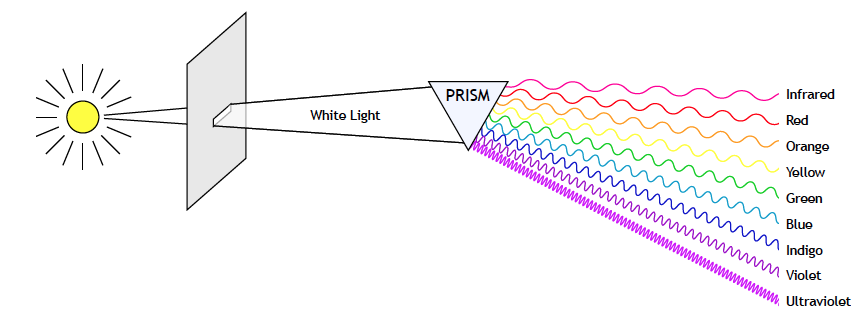
V. Production and Destruction of Ozone
As so often happens in science, Hartley and Cornu’s discovery led to more questions. Why was the ozone layer high in the atmosphere? How did it get there? Was it always there? What would happen if it were not there? What happens to the ozone molecules when they absorb ultraviolet energy? The answers to these questions have come from a variety of fields—including chemistry, physics, meteorology, and astronomy.
The violent processes that go on in the heart of the Sun release vast amounts of energy that radiate in all directions through space at the speed of light. After traveling for about eight minutes, a tiny fraction of the total energy is intercepted by the Earth. A portion of the energy coming from the Sun is in the form of ultraviolet energy, or UV.
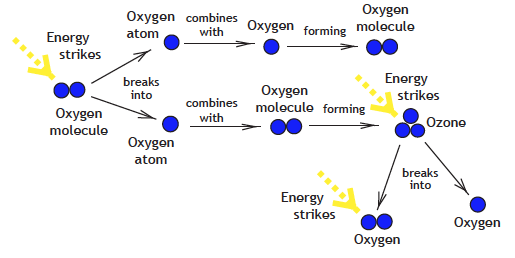
Streaming unhindered through the upper atmosphere ultraviolet energy encounters dioxygen molecules in the stratosphere. The UV energy acts just like lightning, breaking up the molecules of oxygen into atoms which can combine to form molecules of ozone. When ozone absorbs UV energy it is broken into a molecule of dioxygen and a free atom of oxygen. Thus, the ozone layer is like a dance, with oxygen atoms continuously changing—dancing by themselves, or in twos or threes, absorbing UV energy every time they switch partners. The chemical changes caused by the interaction of molecules with UV light are called photo-chemical reactions.
VI. Levels of Natural Ozone Production
The natural processes of ozone production and destruction result in a more or less stable number of ozone molecules in the upper atmosphere. If, for example, the number of ozone molecules should decline, more ultraviolet energy would penetrate further into the atmosphere. This would have the effect of increasing the chances of the radiation striking an oxygen molecule and producing more ozone a little lower in the atmosphere.
If, on the other hand, the number of ozone molecules should increase above the normal number, there would be more ozone targets for the ultraviolet radiation to hit and more of the ozone molecules would break down. Also, ozone is more reactive than dioxygen, and more ozone would be available for chemical reactions with other types of molecules. In effect, the number of ozone molecules present affects the number produced and the number broken down. When there are fewer ozone molecules an increase in production occurs. When there is an excess of ozone molecules, more of them are broken down. Thus a stable level of ozone gas is maintained.
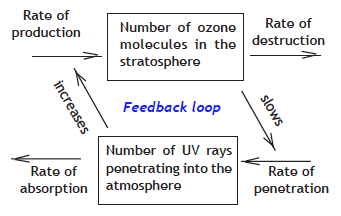
This kind of self-regulating process is called a negative feedback effect. It is called negative, not because it is bad, but because any slight change in conditions creates a new condition that helps to reduce that change.
In the system of interactions that produces ozone, the stable condition produced by the negative feedback effects is known as a stable equilibrium. In the system that is the stratosphere, the level of ozone stays within certain limits. Negative feedback occurs often in natural systems and serves to maintain the system within certain levels.
VII. Natural Rhythms of Ozone Production
There are natural changes in this feedback system. The production and destruction of ozone depends on the intensity of the solar UV radiation. During the winter months at each pole, there is no sunlight so there is no ozone production. During the summer, the poles experience a maximum intensity of light so there is increased production of ozone.
Since the intensity of the Sun’s UV is greatest in the tropics, the primary source of ozone formation is found near the Equator in the middle and upper stratosphere.
The Sun generates more intense radiation during periods when sunspot activity is greatest (called the solar maxima), which occur in an 11-year cycle. The emission of UV is greatest from the areas of the sunspots, which are generally clustered in one or two spots on the Sun. As the Sun rotates through its 27-day period, an increase of ozone production of a few percent occurs when the sunspots are facing the Earth each 27 days.
Temperature controls the rates of ozone production and destruction. The warmer the temperature, the slower the generation of ozone. Conversely, temperature in the stratosphere is affected by the amounts of ozone. The greater the amount of ozone destroyed by interactions with UV, the greater the warming, which slows the process of ozone formation. This is a negative feedback control on the formation of ozone in the tropics. It helps create a regulated amount of ozone.
Heating in the stratosphere caused by the breakdown of ozone causes a current of air that slowly transports ozone formed in the tropics toward the poles.
As described above, natural processes control the amount of ozone, so there is never too much or too little in the stratosphere. Sometimes the natural system is overwhelmed by another influence and the stable condition, or equilibrium, may change. That is what was happening over the Antarctic. During the spring something upsets the natural feedback arrangement and the level of ozone is reduced by 50% or more.
VIII. The Earth Without Ozone
For most of the Earth’s existence, there was not enough oxygen in the air to produce an ozone layer. But thanks to the evolution and widespread growth of blue-green algae, more and more oxygen was injected into the Earth’s atmosphere.
The early atmosphere of the Earth was the product of volcanic eruptions and gas escaping from the cooling solid Earth. Atmospheric chemists believe that the original atmosphere “quickly” formed during the first few hundred million years after the formation of the Earth, 4.5 billion years ago. Studies of ancient rocks that formed a billion years later confirm that the early atmosphere did not contain oxygen. Without oxygen in the atmosphere there was no ozone.
Prior to the production of an oxygen-rich atmosphere, intense rays of ultraviolet energy must have bombarded the Earth’s surface. Excess ultraviolet radiation is deadly to life because it can disrupt the functioning of the living cell. Even water is not a perfect shield from ultraviolet rays as you may well guess since you can get a severe sunburn while swimming! Living things require water tens of meters deep before having complete protection from UV. Research continues in an attempt to identify how early microorganisms were protected from deadly UV radiation.
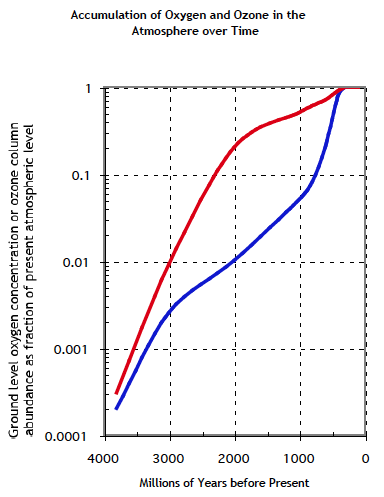
By 1.5 billion years after the Earth’s formation, there were many forms of very simple life that drifted and swam in the waters of the world. Among them was a species of small plant called blue-green algae. As a by-product of its life functions this tiny plant produced minute quantities of oxygen. Huge numbers of these plants over the course of billions of years produced enough oxygen to change the atmosphere and the history of the Earth.
At first much of the oxygen released by the blue-green algae combined chemically with compounds floating in the water. Eventually, after more than two billion years of reacting with the huge reservoir of oxygen-loving compounds in the oceans, some of the oxygen bubbled out of the water into the atmosphere: molecules of oxygen gas formed.
Little by little the quantity of oxygen gas in the air increased. As the amount of oxygen increased so did the ozone in the upper atmosphere. Protected from UV by the ozone layer, organisms evolved that could exist out of the water, and a new chapter in the history of the Earth was opened—evolution of life on land was possible. The earliest fossil land plants date back to nearly 400 million years ago.
As we’ll see in Chapter 3, the continued presence of this layer of ozone high in the stratosphere is essential to the health of both plants and animals that live on land. First, however, we’ll follow the ozone mystery story from its beginning in Wilmington, Delaware, in the 1930s to its conclusion at the South Pole in the 1980s.

